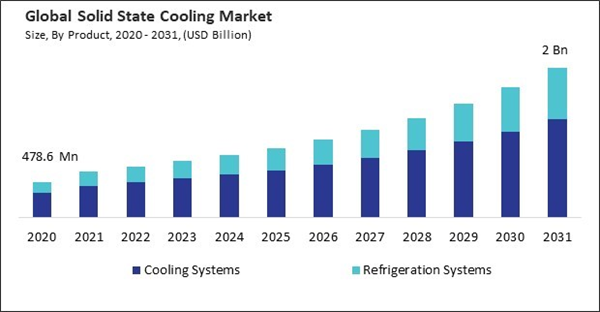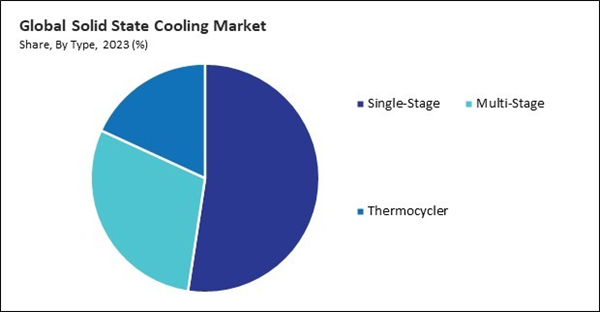The automotive industry is integrating state-of-the-art technologies to improve operational effectiveness and efficiency. Solid-state cooling technology plays a crucial role in this transformation, particularly in cooling electronic components, batteries, and thermal management systems in EVs. Consequently, the automotive segment would generate approximately 15.92% share of the market by 2031. As an effort to mitigate the impacts of climate change and decrease emissions of greenhouse gases, there is a growing inclination towards the implementation of electric mobility.
The increasing power and compactness of electronic devices are resulting in a decline in the efficiency of conventional cooling methods, including heat sinks and fans, due to spatial constraints. Solid-state cooling technology solves this challenge by providing efficient cooling in a compact form factor. Thus, the miniaturization of electronics is driving the adoption of solid-state cooling technology across a wide range of industries.
Additionally, Technological advancements are leading to new materials and techniques that enhance the cooling capacity, efficiency, and reliability of solid-state cooling systems, making them more attractive for various applications. One key area of advancement is the development of novel thermoelectric materials with improved properties. Hence, technological advancements in materials science and manufacturing processes are driving significant improvements in solid-state cooling devices' efficiency, performance, and reliability.
However, The upfront costs of purchasing solid-state cooling systems and related equipment, as well as the costs of installation and integration into existing infrastructure, can be substantial. Small & medium-sized enterprises (SMEs) or organizations operating on a budgetary constraint may find this to be an impediment to the adoption process. Hence, these factors may slow the adoption of the solid-state cooling technology.
By Product Analysis
Based on product, the market is characterized into refrigeration systems and cooling systems. The refrigeration systems segment procured a 30.69 % growth rate in the market in 2022. The ability of solid-state cooling technology to offer precise temperature control and reduce energy consumption makes it an attractive choice for refrigeration applications. Solid-state cooling technology is used in research and laboratory settings for cooling analytical instruments, such as spectrometers and microscopes, to ensure accurate and reliable results. It is also used in pharmaceutical refrigeration units to store temperature-sensitive medications and vaccines at precise and stable temperatures to maintain efficacy.By Type Analysis
By type, the market is divided into single-stage, multi-stage, and thermocycler. The single-stage segment witnessed a 52.39% revenue share in the market in 2022. Single-stage solid-state cooling systems are typically used for applications where moderate cooling requirements are needed, and they offer advantages such as simplicity, reliability, and cost-effectiveness compared to more complex multi-stage systems. Single-stage solid-state cooling systems are used in medical devices, such as blood analyzers and laser systems, to maintain stable temperatures for accurate diagnostics and treatment. Single-stage solid-state cooling systems are used in portable coolers, refrigerators, and wine coolers for camping, picnics, and other outdoor activities. They offer quiet and energy-efficient cooling solutions.By Technology Analysis
On the basis of technology, the market is classified into thermoelectric cooling, electrocaloric cooling, magnetocaloric cooling, and others. The electrocaloric cooling segment recorded a 30.0 % revenue share in the market in 2022. This segment involves the use of electrocaloric materials to achieve cooling effects. Electrocaloric materials exhibit a reversible change in temperature when an electric field is applied, making them suitable for solid-state cooling applications. Achieving economic viability for these materials across a broad spectrum of applications, such as air conditioning, refrigeration, and electronic device cooling, is the overarching objective.By Vertical Analysis
Based on vertical, the market is segmented into semiconductor & electronics, automotive, healthcare, residential, and others. The healthcare segment procured a 36.14 % revenue share in the market in 2022. Many medications and vaccines used in healthcare are temperature-sensitive and require precise temperature control for storage and transportation. Solid-state cooling technology offers a reliable and energy-efficient solution for maintaining the integrity of these medications. Additionally, medical devices such as MRI machines, CT scanners, and laser systems generate heat during operation and require effective cooling systems to maintain optimal performance.By Regional Analysis
Region-wise, the market is analyzed across North America, Europe, Asia Pacific, and LAMEA. The North America segment witnessed a 29.80 % growth rate in the market in 2022. North America has a growing demand for energy-efficient cooling solutions, driven by concerns about energy consumption and environmental impact. Solid-state cooling technology offers a more efficient alternative to traditional cooling methods. Many companies in North America are investing heavily in research and development to further improve solid-state cooling technology, driving innovation and market growth.List of Key Companies Profiled
- Crystal Ltd.
- CUI Devices (Back Porch International, Inc.)
- Delta Electronics, Inc.
- Ferrotec Holdings Corporation
- Coherent Corp.
- Komatsu Ltd.
- Laird Thermal Systems, Inc.
- Solid State Cooling Systems, Inc.
- TE Technology, Inc.
- TEC Microsystems GmbH
Market Report Segmentation
By Product- Cooling Systems
- Refrigeration Systems
- Single-Stage
- Multi-Stage
- Thermocycler
- Thermoelectric Cooling
- Electrocaloric Cooling
- Magnetocaloric Cooling
- Others
- Healthcare
- Semiconductor & Electronics
- Automotive
- Residential
- Others
- North America
- US
- Canada
- Mexico
- Rest of North America
- Europe
- Germany
- UK
- France
- Russia
- Spain
- Italy
- Rest of Europe
- Asia Pacific
- China
- Japan
- India
- South Korea
- Singapore
- Malaysia
- Rest of Asia Pacific
- LAMEA
- Brazil
- Argentina
- UAE
- Saudi Arabia
- South Africa
- Nigeria
- Rest of LAMEA
Table of Contents
Companies Mentioned
- Crystal Ltd.
- CUI Devices (Back Porch International, Inc.)
- Delta Electronics, Inc.
- Ferrotec Holdings Corporation
- Coherent Corp.
- Komatsu Ltd.
- Laird Thermal Systems, Inc.
- Solid State Cooling Systems, Inc.
- TE Technology, Inc.
- TEC Microsystems GmbH










